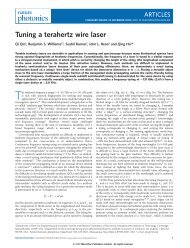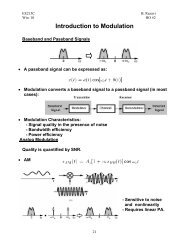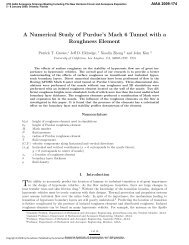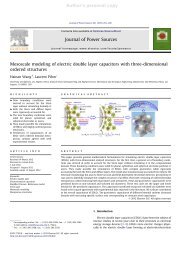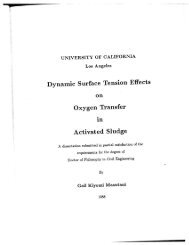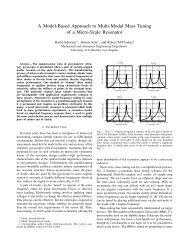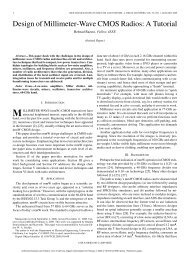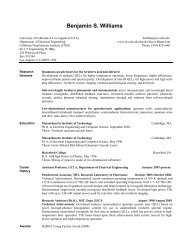Nuclear norm system identification with missing inputs and outputs
Nuclear norm system identification with missing inputs and outputs
Nuclear norm system identification with missing inputs and outputs
Create successful ePaper yourself
Turn your PDF publications into a flip-book with our unique Google optimized e-Paper software.
This condition holds generically when the <strong>inputs</strong> are chosen at r<strong>and</strong>om. Under this assumptionthe first term on the right-h<strong>and</strong> side of (4) has rank n x <strong>and</strong> its range equals the rangeof O r . In the absence of noise (E = 0), one therefore hasn x = rank(Y 0,r,N Π 0,r,N ), range(O r ) = range(Y 0,r,N Π 0,r,N ).In the presence of noise (E ≠ 0), these identities hold only approximately <strong>and</strong> one can estimatenx <strong>and</strong>range(O r )fromalow-rankapproximationofY 0,r,N Π 0,r,N , obtainedbytruncatingan SVD.An efficient implementation of this scheme is the MOESP (MIMO Output-Error State-Space) algorithm [20]. In this method one first computes an LQ factorization[ ]U0,r,N=Y 0,r,N[ ][ ]L11 0 Q1L 21 L 22 Q 2of the stacked input <strong>and</strong> output Hankel matrices. The diagonal blocks L 11 <strong>and</strong> L 22 aretriangular matrices of order rn m <strong>and</strong> rn p , respectively. The matrices Q 1 <strong>and</strong> Q 2 have Ncolumns <strong>and</strong> satisfy Q 1 Q T 1 = I, Q 2 Q T 2 = I, Q 1 Q T 2 = 0. We have Π 0,r,N = I −Q T 1Q 1 <strong>and</strong>HenceY 0,r,N Π 0,r,N = (L 21 Q 1 +L 22 Q 2 )(I −Q T 1Q 1 ) = L 22 Q 2 .range(Y 0,r,N Π 0,r,N ) = range(L 22 )<strong>and</strong> the range space of O r can be estimated from an SVD of L 22 .Instrumental variables. The basic projection method described in the previous paragraphis not consistent: the range of Y 0,r,N Π 0,r,N does not necessarily converge to the range of O ras N goes to infinity. This deficiency can be resolved by the use of instrumental variables[21, 22]. We define an instrumental variable matrix[ ]U−s,s,NΦ =(7)Y −s,s,Nby combining Hankel matrices of ‘past’ <strong>inputs</strong> <strong>and</strong> <strong>outputs</strong>. (More generally, one can usedifferent row dimensions for the two Hankel matrices in Φ, but we will take them equal forsimplicity. In the experiments of section 5 we will use s = r.) Multiplying (4) on the right<strong>with</strong> Φ T givesY 0,r,N Π 0,r,N Φ T = O r X 0,1,N Π 0,r,N Φ T +EΠ 0,r,N Φ T .It can be shown that lim N→∞ (1/N)EΠ 0,r,N Φ T = 0 <strong>and</strong> that, under weak assumptions, thelimit1limN→∞ N X 0,1,NΠ 0,r,N Φ Thas full rank n x (see [8, §9.6] for a detailed discussion). As a consequence, the range ofY 0,r,N Π 0,r,N Φ T gives a consistent estimate of the range of O r . In practice, for finite N, atruncated SVD of Y 0,r,N Π 0,r,N Φ T is used to estimate range(O r ).4(6)



